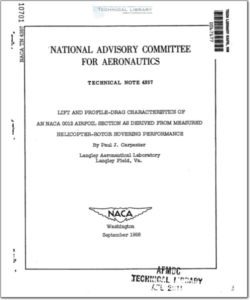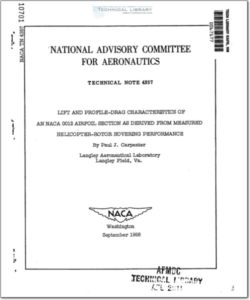NACA-TN-4357

- Version
- 236 Downloads
- 1.03 MB File Size
- 1 File Count
- March 24, 2016 Create Date
- March 24, 2016 Last Updated
National Advisory Committee for Aeronautics, Technical Notes - Lift and Profile-Drag Characteristics of an NACA 0012 Airfoil Section as Derived from Measured Helicopter-Rotor Hovering Performance

Synthesized rotor-blade section lift and profile-drag characteristics
for an NACA 0012 airfoil section as a function of angle of attack and Mach
number for use in calculations of helicOpter-rotor hovering performance
are presented. Measured rotor hovering performance from which the major
portion of the synthesized data was derived is presented for a range of
tip Mach numbers from 0.28 to 0.70. The synthesized data presented for
Mach numbers from 0.70 to 0.88 were derived from a previous investigation
of another blade having an NACA 0012 airfoil section at the tip.
At low tip Mach numbers the synthesized data have higher maximum lift
and lower profile drag at maximum.lift than the equivalent two-dimensional-
airfoil data. At high tip Mach numbers, the rate of increase of drag due
to compressibility is less than that shown by the two-dimensional—airfoil
data.
The rotor-hovering-performance characteristics are similar to those
shown by previously reported investigations at high tip Mach numbers.
The principal effect of increased tip Mach number is a large profile-drag
rise which occurs at progressively lower blade mean lift coefficients.
Current helicopter trends toward increased speed and higher disk
loadings have resulted in increased rotational tip speeds. As a result
of these increased tip speeds, power increases and blade pitching moments
due to compressibility effects have become as important as stall on the
retreating blade in determining the maximum forward speed of the
helicopter.
A numerical-integration method which may be used in calculating
stall and compressibility effects in forward flight has been presented
in reference 1. The accuracy of such calculations depends on the validity
of using two—dimensional airfoil—section data for helicopter performance.
It has been found (at least in the hovering case in refs. 2 and 5) that
using two-dimensional airfoil-section data results in underestimating
low tip Mach number maximum lift and in overestimating the compressibility
drag rise. Two reasons for these discrepancies are apparent: first, the
blade boundary layer is subjected to centrifugal pumping, and, second, the
blade has a finite span and is thus subJect to the drag—alleviating effects
of three-dimensional flow at the blade tip.
| File | Action |
|---|---|
| naca-tn-4357 Lift and Profile-Drag Characteristics of an NACA 0012 Airfoil Section as Derived from Measured Helicopter-Rotor Hovering Performance.pdf | Download |

Comment On This Post